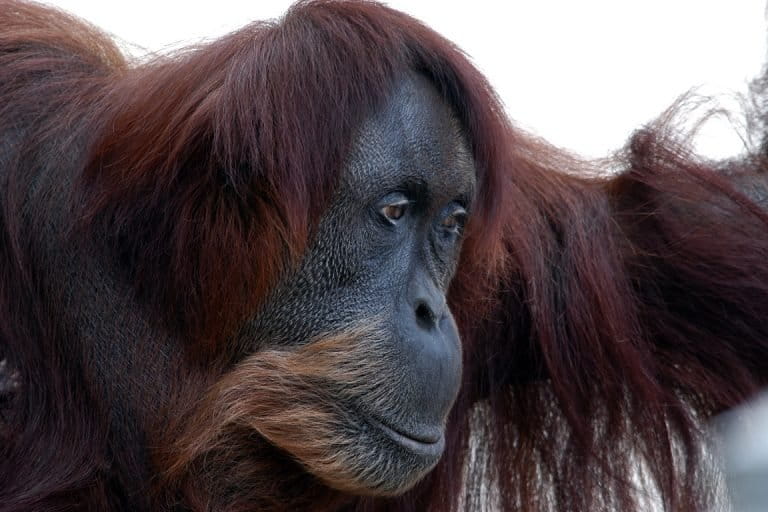- Puan, the world’s oldest living Sumatran orangutan, was euthanized on June 18 at Perth Zoo in Australia due to age-related complications.
- Her death left an incredible legacy of 11 children and a total of 54 descendants across the world, accounting for nearly 10 percent of the global Sumatran orangutan zoo population.
- Due to her genetic legacy, Puan played a vital role in ensuring the survival of the species, which has been categorized as critically endangered.
JAKARTA — Puan, the world’s oldest living Sumatran orangutan, has died at an Australian zoo after a lifetime spent in service to the conservation of the critically endangered species.
Officials at Perth Zoo, where Puan had lived for the past 50 years, euthanized her on June 18, citing age-related health complications. She was 62 years old.
Her death left an “incredible legacy” of 11 children and a total of 54 descendants in Australia, Europe, the United States and in the jungles of Sumatra, accounting for nearly a tenth of the global zoo population of Sumatran orangutans (Pongo abelii), according to a statement from Perth Zoo.
Due to her genetic legacy, Puan played a vital role in ensuring the survival of the heavily threatened species. Of the nine existing wild populations of Sumatran orangutans, only seven — each with an estimated 250 or more individuals — have prospects of long-term viability, according to WWF. Only three of those population groups have more than 1,000 orangutans each.
Some 29 of Puan’s descendants are still alive, including daughters Puteri and Pulang; grandchildren Utama, Teliti, Sekara and Lestari; and great-grandson Sungai, all of whom are also at Perth Zoo.
At 62, Puan exceeded the usual life expectancy for her species. In the wild, female orangutans would rarely live past the age of 50, assuming they succumb earlier to a number of threats such as poaching.
“Puan is the total exception to the rule,” Holly Thompson, a primate superviser at Perth Zoo, said in a video posted on the zoo’s Facebook page. “To be 62 years old is an amazing age for a Sumatran orangutan.”
One of Puan’s great-grandsons, Nyaru, was the latest in the line to be released into the wild.
“I think it’s an amazing legacy for her great grandson Nyaru to be out living his life in the jungles of Sumatra, where his great grandmother hailed from,” zookeeper Martina Hart wrote in an op-ed in the West Australian.
But Puan’s long life and legacy of descendants weren’t the only remarkable things about her. She was said to have motherly mannerisms that befitted her name, which means “lady” in Indonesian, with many describing her as the “grand old lady” of Perth Zoo.
It was her journey and demeanor that made such an impact in people’s hearts.
“[T]he lady we know as Puan is so much more than statistics,” Hart wrote. “To look at Puan is to look into the eyes of an animal (and I find even saying ‘animal’ to feel slightly disrespectful) who has seen so much in her lifetime that the mind boggles.”

Puan was born in the jungle of Sumatra in 1956. On New Year’s Eve in 1968, she was gifted to the zoo by a sultan from Malaysia.
“She really has seen it all, from the jungles of the wild to the old exhibits here at Perth, to our now world class exhibits,” wrote Hart, who knew Puan for almost 18 years. “It fascinates me as to the stories she could tell.”
Despite spending half a century in a zoo environment, Puan never lost her natural and motherly instincts. Hart described her as “the maker of the most amazing nests, and the lady who took no nonsense from her children over the years, but was also the most nurturing mother we had.”
Hart also fondly recalled the day the zoo gave Puan access to a giant fig tree to climb and nest in.
By then, Puan hadn’t been in a real tree for over 50 years.
“To be honest my eyes were filled with tears watching her climbing,” Hart said. “She was the only one who would nest in the tree itself, instead of taking branches back to the platforms to nest. Her instinct and her own mother’s teachings had never left her after all those years.”
Over time, Puan’s eyelashes turned gray, her movements slowed, and her mind started to wander. After various veterinary assessments confirmed that age-related complications were adversely impacting her Puan’s ability to live a quality life, the zoo finally decided to euthanize her.
“It’s very hard for us all to say goodbye to Puan,” a visibly emotional Thompson said in the video. “It’s done in an extremely calm and relaxed manner. Puan went extremely peacefully. She had people that had been working with her for a long, long time, with her to the very end.”
“As hard as it was for us, it was the right thing to do,” Hart added in the video. “We’re going to miss her.”
